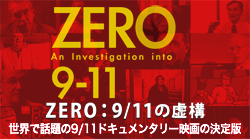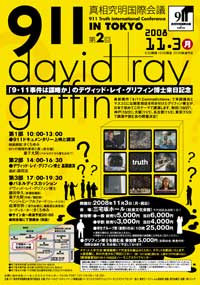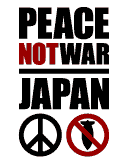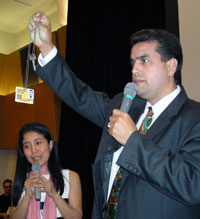http://www.counterpunch.org/takashi04252011.html
It is definitely worth reading and so I am posting it here and on my Japanese blog so it can be seen by a wider audience.
By HIROSE TAKASHI
Translated by Doug Lummis
The nuclear power plants in Japan are ageing rapidly; like cyborgs, they are barely kept in operation by a continuous replacement of parts. And now that Japan has entered a period of earthquake activity and a major accident could happen at any time, the people live in constant state of anxiety.
Seismologists and geologists agree that, after some fifty years of seismic inactivity, with the 1995 Hanshin-Awaji Earthquake (Southern Hyogo Prefecture Earthquake), the country has entered a period of seismic activity. In 2004, the Chuetsu Earthquake hit Niigata Prefecture, doing damage to the village of Yamakoshi. Three years later, in 2007, the Chuetsu Offshore Earthquake severely damaged the nuclear reactors at Kashiwazaki-Kariwa. In 2008, there was an earthquake in Iwate and Miyagi Prefectures, causing a whole mountain to disappear completely. Then in 2009 the Hamaoka nuclear plant was put in a state of emergency by the Suruga Bay Earthquake. And now, in 2011, we have the 3/11 earthquake offshore from the northeast coast. But the period of seismic activity is expected to continue for decades. From the perspective of seismology, a space of 10 or 15 years is but a moment in time.
Because the Pacific Plate, the largest of the plates that envelop the earth, is in motion, I had predicted that there would be major earthquakes all over the world.
And as I had feared, after the Suruga Bay Earthquake of August 2009 came as a triple shock, it was followed in September and October by earthquakes off Samoa, Sumatra, and Vanuatu, of magnitudes between 7.6 and 8.2. That means three to eleven times the force of the Southern Hyogo Prefecture Earthquake.
All of these quakes occurred around the Pacific Plate as the center, and each was located at the boundary of either that plate or a plate under its influence. Then in the following year, 2010, in January there came the Haiti Earthquake, at the boundary of the Caribbean Plate, pushed by the Pacific and Coco Plates, then in February the huge 8.8 magnitude earthquake offshore from Chile. I was praying that this world scale series of earthquakes would come to an end, but the movement of the Pacific Plate shows no sign of stopping, and led in 2011 to the 3/11 Earthquake in northeastern Japan and the subsequent meltdown at the Fukushima
There are large seismic faults, capable of producing earthquakes at the 7 or 8 magnitude level, near each of Japan’s nuclear plants, including the reprocessing plant at Rokkasho. It is hard to believe that there is any nuclear plant that would not be damaged by a magnitude 8 earthquake.
A representative case is the Rokkasho Reprocessing Plant itself, where it has become clear that the fault under the sea nearby also extends inland. The Rokkasho plant, where the nuclear waste (death ash) from all the nuclear plants in Japan is collected, is located on land under which the Pacific Plate and the North American Plate meet. That is, the plate that is the greatest danger to the Rokkasho plant, is now in motion deep beneath Japan.
The Rokkasho plant was originally built with the very low earthquake resistance factor of 375 gals. (Translator’s note: The gal, or galileo, is a unit used to measure peak ground acceleration during earthquakes. Unlike the scales measuring an earthquake’s general intensity, it measures actual ground motion in particular locations.) Today its resistance factor has been raised to only 450 gals, despite the fact that recently in Japan earthquakes registering over 2000 gals have been occurring one after another. Worse, the Shimokita Peninsula is an extremely fragile geologic formation that was at the bottom of the sea as recently as the sea rise of the Jomon period (the Flandrian Transgression) 5000 years ago; if an earthquake occurred there it could be completely destroyed.
The Rokkasho Reprocessing Plant is where expended nuclear fuel from all of Japan’s nuclear power plants is collected, and then reprocessed so as to separate out the plutonium, the uranium, and the remaining highly radioactive liquid waste. In short, it is the most dangerous factory in the world.
At the Rokkasho plant, 240 cubic meters of radioactive liquid waste are now stored. A failure to take care of this properly could lead to a nuclear catastrophe surpassing the meltdown of a reactor. This liquid waste continuously generates heat, and must be constantly cooled. But if an earthquake were to damage the cooling pipes or cut off the electricity, the liquid would begin to boil. According to an analysis prepared by the German nuclear industry, an explosion of this facility could expose persons within a 100 kilometer radius from the plant to radiation 10 to 100 times the lethal level, which presumably means instant death.
On April 7, just one month after the 3/11 earthquake in northeastern Japan, there was a large aftershock. At the Rokkasho Reprocessing Plant the electricity was shut off. The pool containing nuclear fuel and the radioactive liquid waste were (barely) cooled down by the emergency generators, meaning that Japan was brought to the brink of destruction. But the Japanese media, as usual, paid this almost no notice.
The Hamaoka Nuclear Plant is located at Shizuoka City, on Suruga Bay. Despite predictions of a magnitude 8 earthquake on Suruga Bay, it has continued in operation. If you look at the illustration showing the configuration of the plates beneath the Pacific Ocean, you will see that there is a point at which the Philippine Sea Plate, the huge Pacific Plate, the North American Plate, and the Eurasian Plate all meet; directly over that point is the Japanese Archipelago. And the very center of the area where these four plates press together is Shizuoka.
Large scale earthquakes in the eastern and southern seas have occurred regularly at intervals of between 100 and 250 years. Today in 2011, 157 years have passed since the Great Ansei Earthquake of 1854, so we are in a period when the next big one could come at any time. And the predicted center of this expected major earthquake is – though this is hard to believe – exactly under the location of the Hamaoka Nuclear Plant. And sonar readings at the site indicate that from thirty years back the Eurasian plate has been bending, which means that it is in a condition where it can be expected eventually to spring back.
Hirose Takashi has written a whole shelf full of books, mostly on the nuclear power industry and the military-industrial complex. Probably his best known book is Nuclear Power Plants for Tokyo in which he took the logic of the nuke promoters to its logical conclusion: if you are so sure that they're safe, why not build them in the center of the city, instead of hundreds of miles away where you lose half the electricity in the wires?
Douglas Lummis is a political scientist living in Okinawa and the author of Radical Democracy. Lummis can be reached at ideaspeddler@gmail.com


















